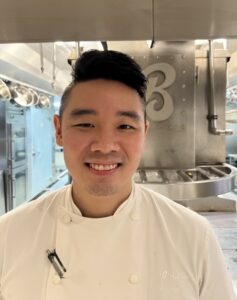
My Ment'or Grant experience was at Seline Restaurant in Santa Monica, CA, which had only been open for seven months at the time of my stage. Chef Dave Beran leads the kitchen with constant evolution, utilizing seasonal farmers’ market produce and foraged herbs. During my stage, I spent one week on AM prep learning the mise en place behind service and three weeks on the line with the PM cooks executing service. The team itself is tight-knit: Chef Dave, Chef Casey (CDC), Chef Jill (the AM Sous), and other line cooks. They welcomed me into their team quickly, and pushed me in the same way as they would any other member.
In the AM, I was able to touch and learn almost every recipe for dinner service. They also changed the menu five different times (adding and removing different dishes and even re-ordering courses), which meant re-learning everything I had already studied. It was a fun challenge. In the PM, the stations are set up with one main cook and the other team members gathering around whichever pass was fired, helping to plate. One of the most exciting parts was that the kitchen team ran a lot of the food to the guests, explaining each dish directly to them. Chef Dave endeavors to bridge the gap between the kitchen and dining room teams, encouraging chefs to interact more with the guests. Learning open-hand service and becoming comfortable interacting with guests was something entirely new to me and was very fun to experience. While I am still not fully comfortable with open-hand service, it is now a skill I want to develop more.
Chef Casey gave me the opportunity to learn every station and taught me new butchery techniques. I practiced breaking down fish that were non-eviscerated, such as rockfish with scales and insides intact. I had to scale and filet fish without damaging the insides and contaminating the fish with blood. I also learned seam butchery when breaking down venison leg, carefully finding different seams and following them down to cleanly separate the muscles. Towards the end of my stage, I was responsible for specific prep items, such as the Kiwi Aguachile and building the Scallop Crudo.
The space at Seline is beautiful and constantly evolving. As I was leaving, the team began discussing plans of creating a garden on the patio space and finding ways to execute bites outside to enhance the dining experience. Beyond that, Chef Dave has a library along the back wall of the kitchen, encouraging cooks to use it: lots of cookbooks and knowledge to explore, from the El Bulli Catalogue to Frantzén to Modernist Cuisine. Many of the staff would come in early and read and study for their own benefit.
Also, since the menu is always changing, we could input our ideas on new dishes. For example, I remember Chef Dave wanting to change one of the desserts. It was the Sorrel Ice Cream course with macerated strawberries and a variety of sorrel. Originally served in a small glass bowl, Chef re-plated it on a plate, breaking up the components and adding a few new ones. The plating was more striking and eye-catching, but one of the cooks asked Chef if it “ate well” and if it made sense. Besides the prettier presentation, how would service need to change in order for the guest to enjoy the dish? Different silverware would be needed. Scooping ice cream off a plate when it would be sliding around did not work. That moment of questioning was all Chef needed to scrap the idea and move on and focus his energy elsewhere. Similarly, there were multiple iterations of a melon dish in development, but none made it on the menu during my stage. I recently saw on Seline’s Instagram a photo of the final dish – it’s exciting to know that they had been refining it all this time.
I also learned different ways the Seline chefs think about food and the breakdown of a menu. They discussed the flow of the menu and arranging it in a way that makes sense for the guest, where it ebbs and flows with peaks and valleys. I learned how an ingredient can be manipulated in multiple ways, but reinforced so that a single ingredient is the focus of the dish. I learned about locality and foraging and the abundance of different herbs, particularly the immense amount of wild fennel in LA. Two to three times a week, I would go with another cook to a local community center that had all sorts of herbs and garnishes that we would pick, such as nasturtium pads and flowers, arugula flowers, fennel fronds, cilantro blooms, bachelor buttons, and more.
Overall, the biggest takeaway from my experience is that there is so much to learn, work on, and improve on. Success is a moving target and we have to keep striving to be better. There are always little refinements that can be made to improve and that journey is incredibly important. I take this mindset with me into Navy Blue. I want the sous chef team to spend more time training the cooks and guiding them through prep items more efficiently. We will teach line cooks how to properly manage their time on the line and how to work quickly and cleanly.